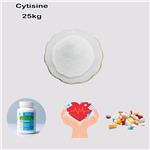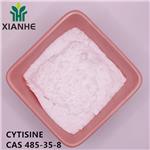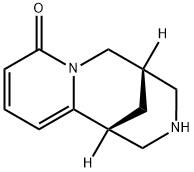The use of cytisine in smoking cessation
Introduction
Cytisine (FIgure 1) is the main alkaloid in the plants of the Faboideae subfamily of the Fabaceae family, which includes the ornamental trees Laburnum anagyroides or Cytisus laburnum and Laburnum alpinum Genista, Sophora and a number of hybrids. Gaius Plinius Secundus, in its book of Naturalis Historia vol Xlll, 73, reports that Cytisus has been well known from antiquity and cultivated in Greece for its beauty, and pharmaco-toxicological properties. The plants are now known as golden chain trees or golden rain acacias, they are common in northern Europe and the mountains of southern Europe and, since antiquity, all of their parts (but particularly the seeds) have been recognised as being poisonous and causing symptoms such as vomiting, pupil dilatation,tachycardia, prostration, torpor, excitement, delirium, hallucinations,muscle twitches, diarrhoea, sweating, and even death due to respiratory paralysis.Cytisine was used in the USSR as a respiratory stimulant similar to lobeline and, since 1960, it has been used to treat nicotinism in Bulgaria and other eastern and central European countries. Cytisine has been marketed in central and eastern Europe as an aid in the clinical management of smoking cessation for more than 50 years. In traditional Chinese medicine it is used to treat hepatitis and liver cancer exploiting a small but promising effect of cytisine on cell growth.[1]

Very recently, a renewed interest in cytisine has arisen not only as an aid to smoking cessation and a possible drug for other pathologies, but also as a template for the synthesis of new cytisine derivatives that should be more target specific and have more appealing pharmacokinetics.[1] Various biological activities of cytisine have been explored, showing certain effects in smoking cessation, reducing drinking behavior, anti-tumor, cardiovascular protection, blood sugar regulation, neuroprotection, osteoporosis prevention and treatment, etc. At the same time, cytisine also has the advantages of high efficiency, safety, and low cost, has broad development prospects, and is a drug of great application value.[2]
Mechanism of Cytisine antismoking action
Its main targets are neuronal nicotinic acetylcholinereceptors (nAChRs), and pre-clinical studies have shown that its interactions with various nAChR subtypeslocated in different areas of the central and peripheral nervous systems are neuroprotective, have a wide range ofbiological effects on nicotine and alcohol addiction, regulate mood, food intake and motor activity, and influencethe autonomic and cardiovascular systems.[1] Cytisine has been classified as a selective partial agonist at α4β2*nAChRs. The alkaloid binds with higher activity to α4β2*nAChRs (K=1.65 nm) than nicotine13 but has only partial efficacy at these receptors in comparison with a full agonist, i.e. nicotine. The agonist activity of cytisine is determined by both receptor activation and receptor desensitization. In a study on the functional effects of cytisine, at a 10 µM concentration and measuring the current evoked at α4β2*, Coe et al. estimated agonistic effects of the alkaloid at 56% of the response to 10µM nicotine. Another study carried out on human α4β2*nAChRs expressed in Xenopus oocytes demonstrated that a brief application of cytisine resulted in activation of these receptors, whereas sustained exposure desensitized the receptors. Desensitization of α4β2*nAChRs was observed at lower concentrations than those needed for activation. Cytisine is less potent in desensitizing α4β2*nAChRs thanvarenicline. Cytisine acts as an antagonist at α4β2*nAChRs; antagonist activity refers to competition with inhaled nicotine for receptor occupancy. When cytisine and nicotine were co-administered, cytisine partially blocked (30% inhibition) the activity of nicotine49. For comparison, varenicline blocked the activity of nicotine by 34%.The interaction of cytisine with α4β2*nAChRs results in the modulation of the release of mesolimbic dopamine associated with pleasure and smoking satisfaction.[3]
Cytisine toxicity and pharmacokinetics
Cytisine toxicity
Before describing the cytisine pharmacological activity it is worth considering its toxicity and pharmacokinetics, two properties that are relevant for the full understanding of its possible pharmaco-therapeutical activity.It has been known since long time that all of the parts of plants containing cytisine are toxic, particularly the seeds. The lethal dose of Laburnum anagyroides/alpinum seeds in sheep and horses is in the order of 0.5 g/kg, whereas well-tolerated chronic ingestion in dogs and rats is between 0.45 and 0.9 mg/kg. The LD50 in rats per oral administration is in the order of 5–50 mg/kg but cytisine does not have embryotoxic or teratogenic activity in experimental animals.In humans, particularly children, cytisine intoxication has effects on the gastrointestinal system (nausea, emesis, and bowel movements), the central nervous system (CNS) (drowsiness, fatigue,dizziness, delirium), and the motor system (muscle twitching and fasciculation, difficulty in walking). The ingestion of seeds of cytisine-containing plants (particularly Spartium junceum or Spanishbroom) by children or animals can induce nicotine-like symptoms that usually fully recover, although some fatal cases havebeen reported. In addition to its nicotinic-related toxicological effects, cytisine has moderate activity as an acetylcholinesterase (AChE) inhibitor. In humans, cytisine may be safe when given in a single4.5 mg dose, which leads to a mean plasma concentration of 50.8±4.7ng/mL: i.e. three times higher than the plasma concentration associated with the single administration of the recommended dose for nicotinism.Moreover, it has been reported that cytisine induces partial seizures in mice, and more recently it has been shown that intraperitoneal injection of a subthreshold dose of cytisine significantly alters the protection provided by some antiepileptic drugs against seizures. [1]
Cytisine pharmacokinetics
On the basis of physico-chemical parameters, it can be argued that protonated cytisine is very hydrophilic, and more lipophilic in a basic environment and therefore easily soluble in gastrointestinal fluids,however its gastrointestinal permeability is limited, and it is the combination of these properties that contribute to its poor bioavailability. In mice, peak blood level is reached two hours after administration, indicating an adsorption rate of 42%. In rabbits, oral bioavailability is 34% and peak plasma concentrations are reached after 35 min.After oral and intravenous administration in mice, the highest concentrations are found in the liver, bile, adrenal gland, and kidney.Brain concentrations in rats are lower than those of equal doses of nicotine or varenicline, a cytisine analogue, because of its low lipophilicity and, probably, a still unknown brain efflux mechanism. It does not reach in brain more than 30% of its plasma concentration,whereas the brain concentration of nicotine under the same conditions is 65% of its plasma concentration. These data indicate poor penetration of the blood-brain barrier (BBB). Cytisine is not metabolised but excreted unchanged in urine. Its t1/2 in rabbits is in the order of 37–52 min. Human data are very scanty but, by taking into account the experimental animal data, it is possible to foresee hypothetical values for the most common kinetic parameters such as its plasma half-life (average 4.8h), peak plasma concentration (1–2h post-dosing) clearance (2–5 mL/min/kg), volume distribution (1.6L/kg), t½ (3.6 h), unbound brain concentration (2–10 nM). Cytisine is eliminated unchanged through the kidneys: after oral or intravenous administration, respectively 18% and 32% of the drug is found in urine after 24 h.[1]
References
1.Gotti C, Clementi F. Cytisine and cytisine derivatives. More than smoking cessation aids. Pharmacol Res. 2021;170:105700. doi:10.1016/j.phrs.2021.105700
2.Wang X, Yang J, Huang P, et al. Cytisine: State of the art in pharmacological activities and pharmacokinetics. Biomed Pharmacother. 2024;171:116210. doi:10.1016/j.biopha.2024.116210
3.Tutka P, Vinnikov D, Courtney RJ, Benowitz NL. Cytisine for nicotine addiction treatment: a review of pharmacology, therapeutics and an update of clinical trial evidence for smoking cessation. Addiction. 2019;114(11):1951-1969. doi:10.1111/add.14721
You may like
See also
Lastest Price from CYTISINE manufacturers

US $0.00-0.00/KG2025-06-27
- CAS:
- 485-35-8
- Min. Order:
- 1KG
- Purity:
- 98%min
- Supply Ability:
- 10kgs

US $0.00/kg2025-04-28
- CAS:
- 485-35-8
- Min. Order:
- 1kg
- Purity:
- 0.99
- Supply Ability:
- 1000kg

